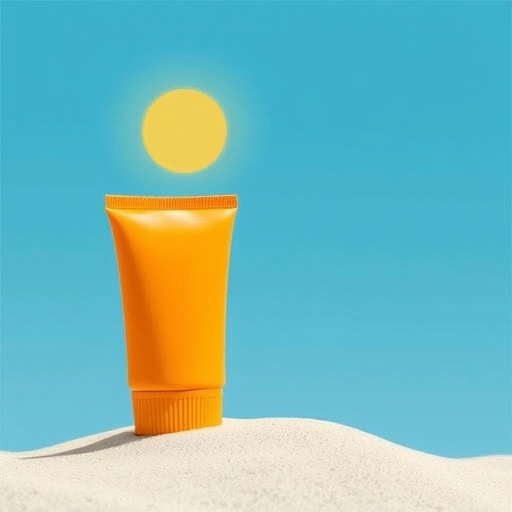In a groundbreaking exploration of sustainable materials, researchers are shifting focus towards valorizing agro-industrial waste through innovative nanocomposite technology. The rise of eco-friendly products is critical in today’s world, where environmental concerns are paramount. This research emphasizes the potential of transforming biomass waste into functional materials that not only serve an industrial purpose but also contribute to consumer health and safety.
The essence of this research revolves around the synthesis of polyphenol-enriched chitosan-PVA-TiO₂ nanocomposites. Researchers undertook this ambitious project to address the dual challenges of waste management and the increasing demand for effective, sustainable photoprotection. The synthesis process entails integrating naturally occurring polyphenols derived from agro-industrial byproducts with chitosan, a biopolymer known for its biodegradability and biocompatibility, which is subsequently combined with polyvinyl alcohol (PVA) and titanium dioxide (TiO₂).
In recent years, the quest for sustainable photoprotective products has seen an upsurge. Traditional sunscreens often rely on synthetic ingredients, potentially harmful to both skin and marine ecosystems. The novel nanocomposites developed in this study present an alternative that not only provides effective UV protection but also utilizes renewable resources effectively. This innovation might well lead to a new generation of sunscreens that prioritize both performance and environmental integrity.
Chitosan, being a derivative of chitin, is abundant in crustacean shells, what makes it a perfect candidate for valorization. Its remarkable properties, including antimicrobial capabilities and excellent film-forming abilities, render it ideal in cosmetic formulations. Researchers incorporated polyphenols into the chitosan-PVA-TiO₂ matrix to enhance the material’s antioxidant attributes, promoting skin health while providing UV protection. This approach aligns with the modern trend of incorporating natural ingredients into skincare products.
Furthermore, the inclusion of titanium dioxide is a crucial factor. This compound not only aids in UV protection but also contributes to the stability and longevity of the formulated products. The challenge lies in controlling the particle size and distribution of TiO₂ within the composite to ensure optimal photoprotection and minimize any potential adverse effects on the skin or the environment. Researchers conducted extensive tests to determine the optimal conditions for synthesizing these nanocomposites, ensuring their efficacy and safety.
The primary goal of this research extends beyond merely creating an effective sunscreen. It addresses the larger issue of waste reduction by exploiting agricultural residues. Utilizing byproducts like fruit peels, seeds, and stems to extract valuable polyphenols challenges conventional waste disposal methods. This innovative approach paves the way for a circular economy model where waste is reimagined as a resource, further contributing to environmental sustainability.
As the study progresses, researchers are keen on evaluating the long-term stability of the synthesized nanocomposites. This involves assessing their performance under various environmental conditions, which is crucial for the potential commercialization of such products. Industry stakeholders are showing an increasing interest in sustainable formulations, and the successful application of these nanocomposites could lead to widespread adoption in the skincare sector.
Extensive testing has been considered necessary to validate the photoprotective effects of these chitosan-PVA-TiO₂ nanocomposites. The underlying research indicates a remarkable capacity to absorb and scatter UV rays, which is essential for any sun-protective product. Researchers developed rigorous in vitro and in vivo evaluation protocols to ensure that these formulations meet the stringent safety and efficacy standards required by consumers and regulatory bodies alike.
In conclusion, the valorization of agro-industrial waste into polyphenol-enriched chitosan-PVA-TiO₂ nanocomposites represents a significant advancement in sustainable materials science. Through this pioneering work, researchers have the potential to revolutionize the market for photoprotective sunscreens by providing an eco-friendly alternative that prioritizes consumer health, environmental responsibility, and innovation. The implications of this research could resonate throughout various industries, promoting the transition from conventional consumer products to sustainable solutions.
As this study gains traction, the scientific community is eager to delve deeper into the adhesive properties of the nanocomposites as well. Understanding how these materials can bond securely to skin while maintaining their integrity over prolonged exposure to sunlight will be key. The anticipated results are not only geared towards sustainability but also enhancing user experience, ensuring that consumers enjoy the benefits of enhanced skin protection without sacrificing their health or contributing to environmental degradation.
Future developments will likely explore the scalability of these nanocomposites, focusing on potential industrial applications. By partnering with agro-industrial sectors, the researchers can facilitate the transformation of waste into economically viable solutions, thus creating a win-win scenario. The overarching vision is to set a precedent for how waste should be viewed—not as a liability but as an opportunity to innovate and protect both consumers and the planet in the process.
The pathway forward is laden with promise and challenges. Continuous research aimed at understanding the lifecycle of these nanocomposites will be essential. By ensuring that the manufacturing processes are not only efficient but also environmentally friendly, researchers can bolster the credibility of these new materials in the broader market. As we move toward a future that embraces sustainability, research like this will play a pivotal role in shaping consumer habits and industrial practices.
Ultimately, the valorization of agricultural waste into high-value products like polyphenol-enriched chitosan-PVA-TiO₂ nanocomposites reflects the boundless possibilities that lie at the intersection of innovation and sustainability. Researchers are committed to not only delivering effective solutions to consumers but also inspiring others to reconsider how waste can be valorized to create a more sustainable future. The journey has only just begun, and its impact may ripple across various sectors, reshaping our understanding of materials, sustainability, and the environment.
Subject of Research: Valorization of Agro-Industrial Waste into Polyphenol-Enriched Chitosan-PVA-TiO2 Nanocomposites for Sustainable Photoprotective Sunscreens.
Article Title: Valorization of Agro-Industrial Waste into Polyphenol-Enriched Chitosan-PVA-TiO2 Nanocomposites for Sustainable Photoprotective Sunscreens.
Article References:
Omari, R.H.A., Abosaoda, M.K., M., R.M. et al. Valorization of Agro-Industrial Waste into Polyphenol-Enriched Chitosan-PVA-TiO2 Nanocomposites for Sustainable Photoprotective Sunscreens.
Waste Biomass Valor (2025). https://doi.org/10.1007/s12649-025-03351-8
Image Credits: AI Generated
DOI: 10.1007/s12649-025-03351-8
Keywords: sustainable materials, agro-industrial waste, polyphenols, chitosan, TiO₂, sunscreens, photoprotection, eco-friendly products.




